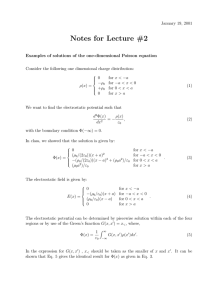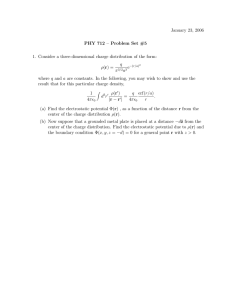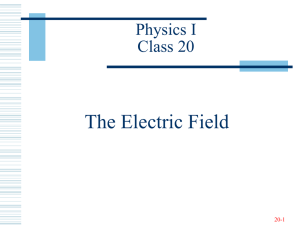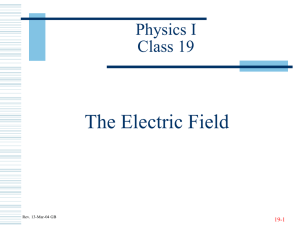Outline Week 6 Electric Fields Electric Potential
advertisement
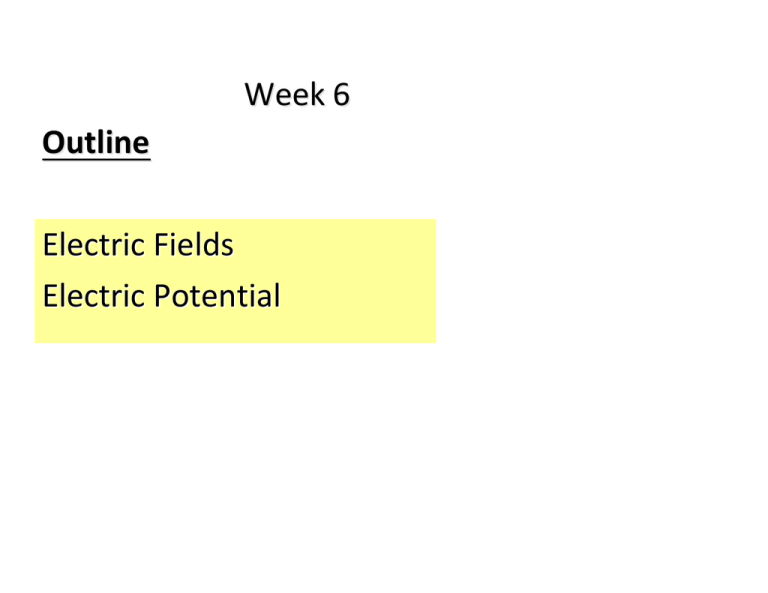
Week 6 Outline Electric Fields Electric Potential Electric fields 3/4/14 Physics 131 2 Electric Field defined at every point in space ! r̂2 r2 r r Kq j E(r) = ∑ 2 r̂j rj qj #3 q3 #2 q2 #1 q1 At reach point in space we can define a vector, E such that the force on a charge q located r r r r at the point r is: F = qE(r) Concept of a “field” is important. Think about the temperature in this room r Temperature is a scalar field. T (r) = T (x, y, z) Fields: Generalizing functions In Calculus and Analytical Geometry Class you learned about functions. f(x) x f(x) : for each value of x the function returns a value for f What if the function depends on more than one variable x? Example: T(x, y, z) Temperature at different points in this room. T(x, y, z) is called a scalar field. E (x, y, z) is called a vector field. The electric field r What does T ( r ) mean? Class room r r − (x, y, z) Me z a vector that locates an arbitrary point in the class room y x r T ( r ) = T (x, y, z) is the value of temperature at point r r − (x, y, z) r r What does E ( r ) mean? Class Room a vector that locates an arbitrary point in the class room Me z r r − (x, y, z) r r r E ( r ) = E(x, y, z) y x is the value ofrelectric field at point r − (x, y, z) r r r r A charge q placed at point r experiences a force F = qE ( r ) Units MKS-­‐SI The force F on a charge q at position r r r r F = qE ( r ) Newtons Coulombs Volts/meter = Newtons/Coulomb But, where does volts come from? r r What does E ( r ) mean? Class Room a vector that locates an arbitrary point in the class room Me z r r − (x, y, z) r r r E ( r ) = E(x, y, z) y x is the value ofrelectric field at point r − (x, y, z) r r r r A charge q placed at point r experiences a force F = qE ( r ) Foothold ideas: Fields A field is is a concept we use to describe anything that exists at all points in space, even if no object is present. A field can have a different magnitude at different points in space. (and if it’s a vector field, direction). Examples: temperature, wind speed, wind direction A gravitational, electric, or magnetic field is a force field. Fields allow us to predict the force that a test object would experience. The field does not depend on what test object is used. A Field has a value at a position in space “ r “ 10/17/12 Physics 131 9 The electric field at a particular point in space B. C. D. E. Depends only on the magnitude of the test charge used to measure it. Depends only on the sign of the test charge used to measure it. Depends on both the sign and magnitude of the test charge used to measure it. Does not depend on the test charge used to measure it. None of the above 20% 20% 20% 20% 20% De pe nd s o nl y o De n pe th nd e m s o ag nl ni y o ... De n th pe nd e sig s o n n of b Do ... ot es h n t he ot d si ep gn en a .. d on th e te No st ... ne o f t he a bo ve A. Physics 132 10 Electric field vectors surrounding a positive charge Arrow gives direction of E field. Darker arrow indicate magnitude of E field 11 Electric field vectors surrounding a negative charge. Draw the electric field vectors around a dipole. Whiteboard, TA & LA Draw the electric field vectors around a dipole. Field directed to right here Field directed to left here Whiteboard, TA & LA Everyone knows the magnitude of the electric field decreases as r-2 where r is the distance from the observation point to the source charge. r r Kq j E(r) = ∑ 2 r̂j rj qj r r −? E(r) ∝ r r A. B. C. D. ?= 1 ?=2 ?=3 ? = 3.14159…. Whiteboard, TA & LA Potential energy 3/4/14 Physics 132 16 Remember our relation between force and work? What is the work done by a force in moving an object a distance Δx? W = F ⋅ Δx = qE ⋅ Δx Potenial energy difference ΔU = −qE ⋅ Δx A positive charge might be placed at one of three spots in a region. It feels the same force (pointing to the left) in each of the spots. How does the electric potential energy, Uelec, on the charge at positions 1, 2, and 3 compare? B. C. D. E. F. U is greatest at 1 U is greatest at 2 U is greatest at 3 U = 0 at all three spots U ≠ 0 but same at all three spots Not enough information 1/23/13 U is gr ea te st U a is t 1 gr ea te s U t a is t 2 gr U ea = t es 0 at t a al t 3 l t hr ee sp ot No s t e no ug h in fo rm at io n A. 17% 17% 17% 17% 17% 17% Physics 132 18 Electrostatic Potential 3/4/14 Physics 131 19 Electric Field and Electric Potential defined at every point in space ! r̂2 r2 r r Kq j E(r) = ∑ 2 r̂j rj qj #3 q3 #2 q2 #1 q1 At reach point in space we can define a vector, E such that the force on a charge q located r r r r at the point r is: Potential energy of charge q Electric potential at point r F = qE(r) Kq j r U(r) = q∑ rj qj Kq j r r V (r) = U(r) / q = ∑ rj qj Positive test charge with positive source Potential energy of a positive test charge near a positive source. kqQ U= r Electric Potential of a positive test charge near a positive source. kQ V= r What happens when I change the sign of the test charge? B. C. D. Potential energy graph changes Electrostatic potential graph changes Both change Neither of the graphs changes 1/23/13 25% 25% 25% 25% Po te nt ia l e ne rg y g El ra ec ph tro ch st an at ic ge po s te nt ia l g ra ph ... Ne Bo ith th er ch o an f t ge he gr ap hs ch an ge s A. Physics 132 22 Negative test charge Potential energy of a negative test charge near a positive source. kqQ U= r Electric Potential of a negative test charge near a positive source. kQ V= r Foothold ideas: Energies between charges The potential energy between two charges is Kq1q2 U = r12 between many charges The potential energy elec 12 is elec 12...N U 2/24/14 = N kC qi q j i < j =1 rij ∑ Physics 132 24 Foothold ideas: Electrostatic potential energy and potential The potential energy between kC Q1Q2 ele c U = 1 2 two charges is r1 2 N k C QiQ j The potential energy of ele c U12... N = ∑ many charges is rij i < j =1 The potential energy added by adding a test charge q is ΔU 2/22/13 N e lec q kC qQ i =∑ = qV riq i =1 Physics 132 Potentials 25 Foothold ideas: Electrostatic Potential energy and Electrostatic Potential Again we focus our attention on a test charge! Usual definition of “electrostatic potential energy”: How much does the energy of our system change if we add the test charge It’s really a change in potential energy! We ignore the electrostatic potential energies of all other pairs (since we assume the other charges do not move) We can pull the test charge magnitude out of the equation and obtain en electrostatic potential 2/15/13 Physics 132 26 C. D. 1/23/13 Physics 132 al le r Yo u ca th n’ e t t sa el m l f e ro m th e in fo r.. . B. greater smaller the same You can’t tell from the information given sm A. gr ea te r Two charges are brought separately into the vicinity of a charge +Q. First, charge +q is brought to point A a distance r from +Q. Next, +q is removed and a charge +2q is brought to25% 25% 25% 25% point B a distance 2r from +Q. Compared with the electrostatic potential of the charge at A, that of the charge at B is 27


